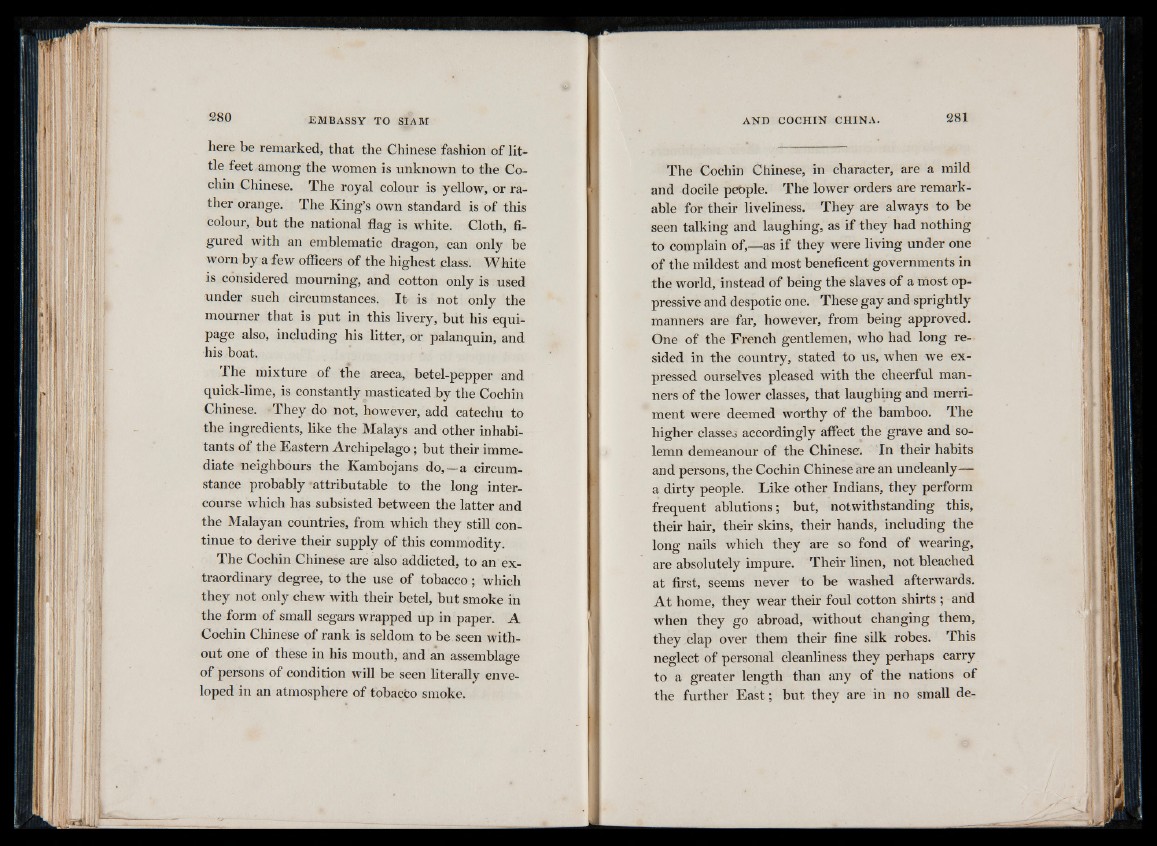
here be remarked, that the Chinese fashion of little
feet among the women is unknown to the Cochin
Chinese. The royal colour is yellow, or rather
orange. The King’s own standard is of this
colour, but the national flag is white. Cloth, figured
with an emblematic dragon, can only be
worn by a few officers of the highest class. White
is considered mourning, and cotton only is used
under such circumstances. I t is not only the
mourner that is put in this livery, but his equipage
also, including his litter, or palanquin, and
his boat.
The mixture of the areca, betel-pepper and
quick-lime, is constantly masticated by the Cochin
Chinese. They do not, however, add catechu to
the ingredients, like the Malays and other inhabitants
of the Eastern Archipelago; but their immediate
neighbours the Kambojans do,—a circumstance
probably -attributable to the long intercourse
which has subsisted between the latter and
the Malayan countries, from which they still continue
to derive their supply of this commodity.
The Cochin Chinese are also addicted, to an extraordinary
degree, to the use of tobacco; which
they not only chew with their betel, but smoke in
the form of small segars wrapped up in paper. A
Cochin Chinese of rank is seldom to be seen without
one of these in his mouth, and an assemblage
of persons of condition will be seen literally enveloped
in an atmosphere of tobacco smoke.
The Cochin Chinese, in character, are a mild
and docile people. The lower orders are remarkable
for their liveliness. They are always to be
seen talking and laughing, as if they had nothing
to complain of,—as if they were living under one
of the mildest and most beneficent governments in
the world, instead of being the slaves of a most oppressive
and despotic one. These gay and sprightly
manners are far, however, from being approved.
One of the French gentlemen, who had long resided
in the country, stated to us, when we expressed
ourselves pleased with the cheerful manners
of the lower classes, that laughing and merriment
were deemed worthy of the bamboo. The
higher classes accordingly affect the grave and solemn
demeanour of the Chinese. In their habits
and persons, the Cochin Chinese are an uncleanly—
a dirty people. Like other Indians, they perform
frequent ablutions; but, notwithstanding this,
their hair, their skins, their hands, including the
long nails which they are so fond of wearing,
are absolutely impure. Their linen, not bleached
at first, seems never to be washed afterwards.
A t home, they wear their foul cotton shirts ; and
when they go abroad, without changing them,
they clap over them their fine silk robes. This
neglect of personal cleanliness they perhaps carry
to a greater length than any of the nations of
the further E a s t; but they are in no small de